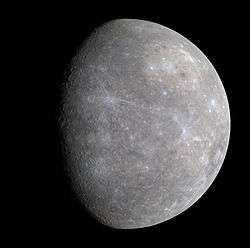Hypothetical moon of Mercury
Mercury's moon would be an undiscovered natural satellite orbiting the planet Mercury. One was briefly thought to exist in the early 1970s, but it turned out to be misinterpreted data from a star.[1] Observation of a moon of Mercury from Earth would be difficult because Mercury is relatively close to the Sun.[2] For example, Mercury was not observed in the infrared spectrum until 1995.[2] NASA's MESSENGER spacecraft, which orbited Mercury from 2011 to 2015, did not detect any moon.[3][4]
Mariner 10 mission
A moon of Mercury was for a short time thought to exist. On March 27, 1974, two days before Mariner 10 made its flyby of Mercury, instruments began registering large amounts of ultraviolet radiation in the vicinity of Mercury that, according to one astronomer, "had no right to be there".[1] By the next day, the radiation had disappeared; it reappeared three days later, appearing to originate from an object that was, seemingly, detached from Mercury.[1] Some astronomers speculated that they had detected a star, but others argued that the object must be a moon, citing not only the two different directions from which the radiation had emanated, but also the belief that such high-energy radiation could not penetrate very far through the interstellar medium.[1] Arguments in favor of a moon were strengthened when the object's speed was calculated to be 4 kilometres per second (2.5 mi/s), which matched the expected speed of a moon.[1]
31 Crateris

A "moon" was detected moving away from Mercury in 1974, and was, eventually, identified as a star in the background, 31 Crateris. 31 Crateris happens to be a spectroscopic binary with a period of 2.9 days, and this may have been the source of the ultraviolet radiation detected in 1974.[5]
The 'moon of Mercury' misidentification in 1974 sparked an important discovery in astronomy: ultraviolet radiation, it was found, is not as completely absorbed by the interstellar medium as was formerly thought.
MESSENGER mission
NASA jokingly proposed the name Caduceus, after the staff carried by the Roman god Mercury, during an April Fools' Day joke in 2012 in which the MESSENGER spacecraft supposedly discovered a moon while in orbit around Mercury.[6] MESSENGER mission used the spacecraft to search for moons of Mercury in 2011 and 2013.[7]
See also
References
- 1 2 3 4 5 Mercury's Moon. "Hypothetical Planets". Paul Schlyter. 2009.
- 1 2 Malcolm W. Browne - An Airborne Telescope Risks a Look At Mercury (1995) - The New York Times
- ↑ "MESSENGER Provides New Look at Mercury's Landscape, Metallic Core, and Polar Shadows" (Press release). Johns Hopkins University. March 21, 2012. Retrieved 2012-03-22.
- ↑ A lot of moons or no moons at all? NASA. 5 November 2015.
- 1 2 Stratford, R.L. (October 1980). "31 Crateris reexamined". The Observatory. 100: 168. Bibcode:1980Obs...100..168S. (HD 104337 near 11 58 17.515 -19 22 50.18)
- ↑ NASA - Featured Image (Note inset seems to show 243 Ida)
- ↑ MESSENGER to Capture Images of Earth and Moon During Search for Satellites of Mercury (2013)
